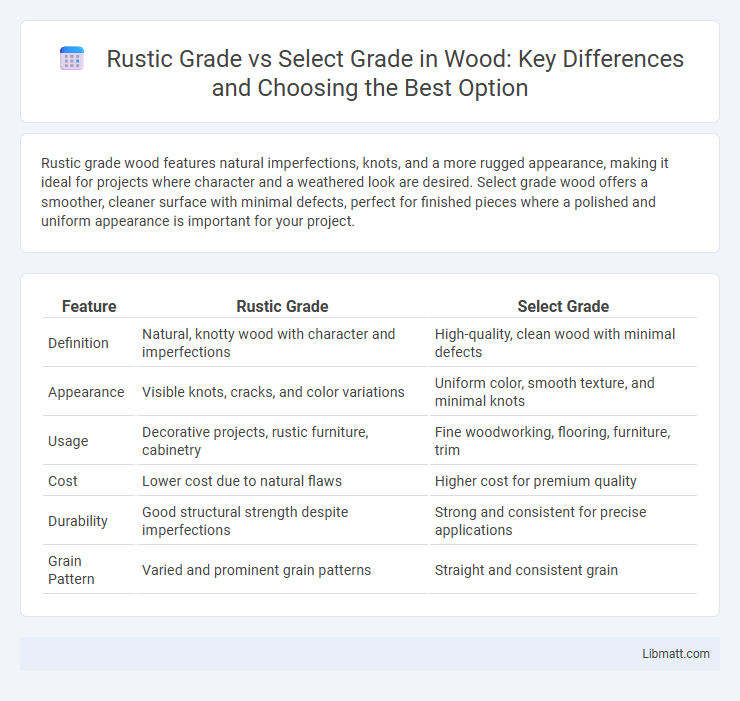Rustic grade wood features natural imperfections, knots, and a more rugged appearance, making it ideal for projects where character and a weathered look are desired. Select grade wood offers a smoother, cleaner surface with minimal defects, perfect for finished pieces where a polished and uniform appearance is important for your project.
Table of Comparison
| Feature | Rustic Grade | Select Grade |
|---|---|---|
| Definition | Natural, knotty wood with character and imperfections | High-quality, clean wood with minimal defects |
| Appearance | Visible knots, cracks, and color variations | Uniform color, smooth texture, and minimal knots |
| Usage | Decorative projects, rustic furniture, cabinetry | Fine woodworking, flooring, furniture, trim |
| Cost | Lower cost due to natural flaws | Higher cost for premium quality |
| Durability | Good structural strength despite imperfections | Strong and consistent for precise applications |
| Grain Pattern | Varied and prominent grain patterns | Straight and consistent grain |
Understanding Rustic Grade and Select Grade
Rustic grade wood features natural characteristics like knots, cracks, and color variations that emphasize a rugged, authentic appearance ideal for creating a cozy, warm atmosphere. Select grade wood displays a more uniform, smooth surface with minimal imperfections, offering a refined, polished look perfect for modern or formal settings. Choosing between rustic and select grade depends on your aesthetic preference and the desired visual impact of your wood flooring or cabinetry.
Key Differences Between Rustic and Select Grades
Rustic grade wood features prominent knots, color variations, and natural imperfections, creating a highly authentic, weathered look ideal for rustic or farmhouse styles. Select grade wood offers a cleaner, more uniform appearance with minimal knots and defects, making it suitable for modern interiors requiring a polished finish. Your choice depends on whether you prefer the character of rustic charm or the sleek consistency of select grade materials.
Visual Characteristics: Rustic vs Select
Rustic grade wood features prominent knots, cracks, and color variations, emphasizing a natural, rugged appearance ideal for creating a warm, country-style ambiance. Select grade wood presents a cleaner, more uniform look with minimal knots and consistent color, providing a refined and polished finish suitable for modern or formal settings. Visual characteristics distinguish rustic wood by its textured, imperfect charm, while select wood offers smoothness and subtle elegance.
Material Sourcing and Quality Standards
Rustic grade wood is sourced from trees with natural imperfections, knots, and color variations, highlighting authentic character but with less uniformity and lower visual quality compared to Select grade wood. Select grade material undergoes strict quality standards and careful selection, ensuring consistent strength, minimal defects, and an even grain pattern ideal for refined finishes. These distinct sourcing and quality criteria influence durability and aesthetic appeal, with Select grade favored for high-end applications demanding precision and Rustic grade preferred for more natural, handcrafted looks.
Durability and Longevity Comparison
Rustic grade wood features natural knots and imperfections, which may reduce its overall durability compared to Select grade wood, known for its uniformity and fewer defects. Select grade wood typically offers greater longevity due to its higher structural integrity and resistance to wear and tear. Both grades can be sealed and treated, but Select grade generally ensures a longer lifespan in flooring, cabinetry, and furniture applications.
Cost Differences: Rustic Grade vs Select Grade
Rustic grade wood is typically more affordable than select grade due to its natural knots, color variations, and imperfections that are accepted in the grading standards. Select grade offers a cleaner, more uniform appearance with fewer defects, which increases processing costs and retail price. The cost difference can range from 20% to 50%, depending on species and market availability.
Best Applications for Each Grade
Rustic grade wood, characterized by prominent knots and natural imperfections, is best suited for applications that emphasize a rugged, natural aesthetic such as farmhouse furniture, accent walls, and outdoor structures. Select grade wood offers a smoother, more uniform appearance with minimal imperfections, making it ideal for fine cabinetry, trim work, and high-end flooring where a polished finish is desired. Choosing the right grade depends on your project's visual goals and the desired balance between character and refinement.
Design Aesthetics and Style Preferences
Rustic grade wood showcases natural knots, cracks, and color variations that create a warm, inviting aesthetic perfect for farmhouse or country-style interiors. Select grade wood offers a cleaner, more uniform appearance with minimal imperfections, ideal for contemporary or formal design preferences. Your choice between these grades will significantly influence the overall style and ambiance of your space.
Maintenance Requirements and Considerations
Rustic grade wood features natural imperfections and knots that may require more frequent maintenance to prevent damage and preserve its rugged appearance. Select grade wood offers a smoother, cleaner surface that generally demands less upkeep and easier cleaning to maintain its polished look. Your choice between Rustic and Select grade will influence how much time and effort you invest in routine care and long-term durability.
Choosing the Right Grade for Your Project
Selecting the right wood grade depends on the desired aesthetic and project requirements, with Rustic grade offering natural knots and imperfections for a character-rich, vintage look, while Select grade provides a clean, uniform appearance ideal for modern or formal designs. Rustic grade suits projects where texture and personality are prioritized, such as farmhouse-style furniture or rustic cabinetry. Select grade is preferable for sleek finishes and durability, often chosen for flooring, trim, or high-end cabinetry where smoothness and consistency are essential.
Rustic grade vs Select grade Infographic

 libmatt.com
libmatt.com